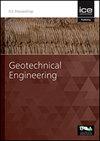腾吉兹雪佛龙未来发展项目-临时运输道路的设计
IF 1.7
4区 工程技术
Q3 ENGINEERING, GEOLOGICAL
Proceedings of the Institution of Civil Engineers-Geotechnical Engineering
Pub Date : 2022-11-21
DOI:10.1680/jgeen.22.00090
引用次数: 0
摘要
位于哈萨克斯坦西部Tengiz油田的Tengiz雪佛龙未来增长项目(TCO FGP)的36公里运输公路为研究重型交通负荷对土方工程的动态影响提供了独特的机会。这条运输公路的建造是为了方便将252个部分建造的模块单元从里海的一个专用码头运输到油田内的施工区域。运输道路下面的地面主要由最近形成的粒状沉积物组成,其中有非常柔软的粘性物质形成的古河道,厚度可达4米。模块单元重达2300吨,由多轮拖车运输,最大分布地面承受压力为80kN/m2。该项目的策略是不处理软粘性土壤下的区域,但在道路运营期间将分配预算用于维护。采用准静态载荷设计了运输道路,并采用极限平衡法和有限元法进行校核。施工计划允许使用在地面勘测期间安装的仪器来完成动态路堤试验,以监测下面土壤的沉降和孔隙水压力反应,并在运输道路运行期间进一步监测。监测结果表明,采用准静态方法计算交通荷载不能真实反映土方工程的短时间动荷载,准静态方法计算移动荷载具有较高的保守性。本文章由计算机程序翻译,如有差异,请以英文原文为准。
TengizChevroil Future Growth Project – The Design of Temporary Haul Roads
The 36 kilometre haul road for the TengizChevroil Future Growth Project (TCO FGP) at the Tengiz oilfield in Western Kazakhstan provided a unique opportunity to examine the dynamic effect of heavy traffic loading on earthworks. The haul road was constructed to facilitate transport of 252no partially constructed module units from a purpose built terminal in the Caspian Sea to the construction area within the oilfield. The ground underlying the haul road comprises recent, predominantly granular deposits with palaeo-channels of very soft cohesive material up to 4 metres thick. The module units, weighing up to 2300 tonnes, were transported on multi-wheeled trailers imparting a maximum distributed ground bearing pressure of 80kN/m2. The project strategy was that areas underlain by soft cohesive soils would not be treated but a budget would be allocated for maintenance during operation of the road. The haul road was designed using quasi-static loading with checks using limit equilibrium and finite element methods. The construction programme allowed instrumentation installed during the ground investigation to be used to complete a dynamic embankment trial to monitor settlement and pore water pressure response in the underlying soils, which was supplemented by further monitoring during haul road operation. The monitoring indicated that adoption of the quasi-static approach for traffic loading does not realistically reflect short duration dynamic loading on earthworks and that the quasi-static approach is highly conservative when applied to moving loads.
求助全文
通过发布文献求助,成功后即可免费获取论文全文。
去求助
来源期刊
CiteScore
4.40
自引率
4.50%
发文量
68
审稿时长
3 months
期刊介绍:
Geotechnical Engineering provides a forum for the publication of high quality, topical and relevant technical papers covering all aspects of geotechnical research, design, construction and performance. The journal aims to be of interest to those civil, structural or geotechnical engineering practitioners wishing to develop a greater understanding of the influence of geotechnics on the built environment.

 求助内容:
求助内容: 应助结果提醒方式:
应助结果提醒方式:


